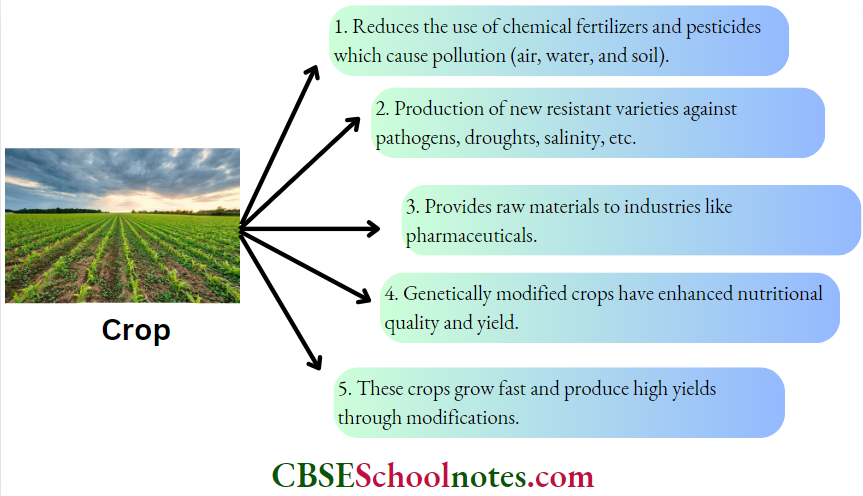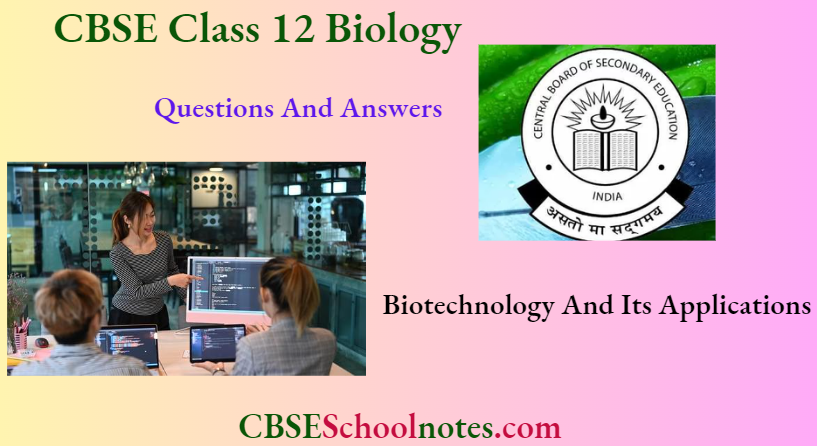Biotechnology And Its Applications Question And Answers
Question 1. Crystals of Bt toxin produced by some bacteria do not kill the bacteria themselves because-
- Bacteria are resistant to the toxin
- The toxin is immature;
- The toxin is inactive ;
- Bacteria enclose toxins in a special sac.
Answer: 3. The toxin is inactive.
Question 2. What are transgenic bacteria? Illustrate using any one example.
Answer:
The bacteria whose DNA is manipulated, carried, and expressed foreign DNA is called transgenic bacteria.
For example, DNA sequences (A and B chains of human insulin) were introduced into the plasmid of bacteria E.coil. The transgenic bacteria start producing an insulin chain,
Question 3. Compare and contrast the advantages and disadvantages of the production of genetically modified crops.
Answer:
Advantages of genetically modified crops:

Disadvantages of genetically modified crops:

Read and Learn More Class 12 Biology Chapter Wise
Question 4. What are Cry proteins? Name an organism that produces it. How has man exploited this protein to his benefit?
Answer:
Cry protein (crystal protein) is a toxin coded by a gene cry and is poisonous to some insects, thus giving resistant characteristics to the plants.
- Bacillus thuringiensisproduces Cry protein.
- Cry protein-producing gene is transferred to the plants to provide resistance against insect larvae.
- Man has developed several transgenic crops by introducing these genes from bacteria to crop plants such as Bt cotton, Bt corn, etc.
Question 5. What is gene therapy? Illustrate using the example of adenosine deaminase (ADA) deficiency.
Answer:
Gene therapy is a method which corrects or replaces the defective genes. [IMP.J
- In 1900, the first clinical gene therapy was given to a 4-year-old girl with adenosine deaminase (ADA) deficiency.
- This enzyme plays an important role in the functioning of the immune system. This disorder is caused due to the deletion of the gene for adenosine deaminase.
- In gene therapy, lymphocytes from the blood of the patient are grown in a culture outside the body.
- A functional ADA cDNA (using a retroviral vector) is then introduced into these lymphocytes, which are returned to the patients. However, as these cells are not immortal, hence the patient requires periodic infusion of such genetically engineered lymphocytes.

Question 6. Diagrams magically represent the experimental steps in cloning and expressing a human gene (Say the gene for growth hormone) into bacterium-like
Answer:
It is possible to produce HGH (human growth hormone) by recombinant DNA technology.
This is represented diagrammatically as follows :

Question 7. Can you suggest a method to remove oil (hydrocarbon) from seeds based on your understanding of rDNA technology and the chemistry of oil?
Answer:
To remove oil from seeds, the genes responsible for the formation of glycerol or fatty acids need to be identified and removed, which is responsible for this synthesis. So, by rDNA technique, one can obtain oil-less seeds by preventing the synthesis of fats.
Question 8. Find out from the internet what is golden rice.
Answer:
- Golden rice is a genetically modified rice that contains p-carotene (provitamin A).
- This rice is modified to enhance the quantity of vitamin – A in it. It is called golden due to the gold-like color it gets from p – p-carotene.
Question 9. Does our blood have proteases and nucleases?
Answer:
Blood does not contain proteases and nucleases because their function is to break down proteins and nucleic acids.
Question 10. Consult the internet and find out how to make orally active protein pharmaceuticals. What is the major problem to be encountered?
Answer:
Orally active protein pharmaceuticals can be made by lining it with a substance that will dissolve after it has passed through the stomach. The major problem encountered is that the stomach enzymes and acids may denature the therapeutic protein and render it ineffective.
